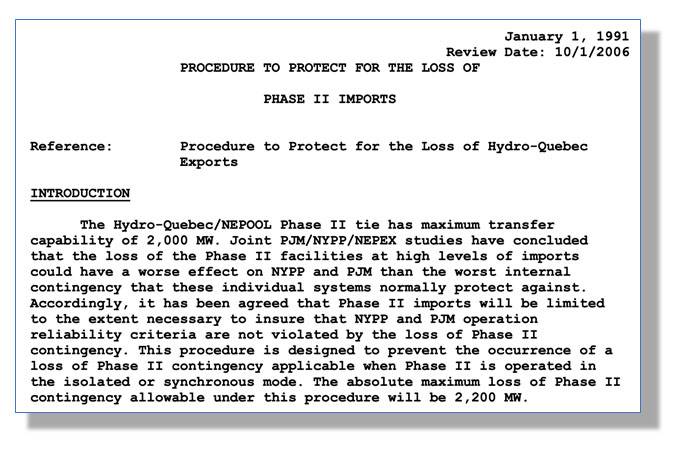
How the Maximum Contingency of 2,200 MW Was Recast to a 1,200 MW Ceiling
As policy makers and energy developers look to develop and interconnect large offshore wind projects in the most economically efficient and least environmentally impactful way, an issue has developed. A relatively recent limit, set in place by the grid operator in New England in a planning process document, states that no single system loss of energy, or “contingency”, can be larger than 1,200 megawatts (MW). This 2016 addition to ISO New England’s (ISO-NE) Planning Procedure No. 5-6 is increasingly creating consternation among both policy makers and developers and threatening to raise the cost and impacts of offshore wind. Part of the reason is that a de facto standard has developed in Europe that utilizes 2,000 MW 525 kilovolt (kV) high voltage direct current (HVDC) cable systems to interconnect offshore wind, with tens of billions of dollars of these systems already ordered and scheduled to be in service by the end of this decade. The 2,000 MW size allows for single wind projects to be larger and benefit from economies of scale spread over more power production per project and significant reductions in the number of HVDC transmission systems needed to connect these projects to the grid. To meet New England’s projected need of 30,000 MW of offshore wind power, 10 more HVDC cables and associated converters at several hundreds of millions of US dollars each would be required if the 1,200 MW single source limit continues to apply.
At the same time, the complex and opaque history of the 1,200 MW limit has led to the impression that this has been a long-standing ceiling in the region and a sense that it would be a significant effort to lift the limit. If the 1,200 MW ceiling is relatively recent, what is the long-standing single source New England loss limit agreed to by the predecessors of the New York Independent System Operator (NYISO), ISO-NE, and PJM Interconnection (PJM) in 1991? 2,200 MW. Instead of a ceiling, the 1,200 MW is a floor that the three systems will redispatch power flows on their system to maintain.
The 1991 agreement, the “Procedure to Protect for the Loss of Phase II Imports,” set 2,200 MW as the single source loss ceiling and established a process for assessing conditions in the NYISO and PJM systems through an examination of seven reactive conditions. In PJM, this consists of power flows across three specified lines, and in NYISO, there are four monitoring points consisting of voltages at three substations and power flows on the Central East Interface. Any restriction below the 2,200 MW level down to 1,200 MW, and any point in between, is an at least hourly calculation involving a control-to-control room check. The 1,200 MW value does not appear in the 1991 agreement, but is observed by the three grid operators as the lower limit under which system operators will redispatch generation to maintain. The 1991 agreement was filed with the Federal Energy Regulatory Commission (FERC) in Docket No. ER07-231-000 on an “informational” basis in November of 2006 because it did not contain “rates, terms, or conditions” under the Federal Power Act (FPA). FERC rejected that informational characterization in its January 12, 2007 order, and accepted the filing under Section 205 of the FPA. The 1991 agreement can be found on the FERC website using the citation 111 FERC ¶ 61,017.
 The introduction of the 1991 Procedure to Protect for the Loss of Phase II Imports
The introduction of the 1991 Procedure to Protect for the Loss of Phase II Imports
In practical terms, this means that, since 1991 until the present day, resources like the Phase II HVDC line from Canada to the United States that can operate at up to 2,000 MW, the Boston-based Mystic Generating Station units 8 and 9, which collectively are a 1,600 MW single source loss due to a common natural gas fuel source issue from an adjacent liquefied natural gas gasification facility, and the region’s two remaining nuclear plants, Seabrook in New Hampshire and Millstone in Connecticut, can all operate above 1,200 MW and up to their limits as long as system generation dispatch and resulting power flows on the New York and PJM systems allow. The 2016 planning process limit only applies prospectively to new resources – HVDC lines interconnecting offshore wind included.
As more focus was placed on the 1,200 MW limit by policy makers and developers, in March of 2023, ISO-NE sent a letter to the Joint ISO/RTO Planning Committee requesting a coordinated study among ISO-NE, NYISO, and PJM to determine if the 1,200 MW limit could be raised. ISO-NE described the 1,200 MW design limit as a means to address the issue as one of “daily unpredictability” regarding the size of the single contingency limit under the 1991 agreement. In its letter, ISO-NE notes the size of larger resources could be “constrained by an otherwise optimal interconnection design,” and asks the Joint ISO/RTO Planning Committee to assess the source limit to see if it can be increased. ISO-NE noted the upper limit for a single system contingency to be 2,000 MW -- instead of the stated 2,200 MW -- and sought study up to that lower 2,000 MW limit. While a 2,000 MW operating ceiling would accommodate the emerging offshore wind transmission standard set in Europe, it is worth noting that this is still 200 MW below the maximum level grid operators identified in 1991 and is contained in the ISO-NE tariff, the only upper limit in a document that has been reviewed and accepted by ISO-NE's regulator, FERC.
One interesting element of the ISO-NE request is that ISO-NE itself that has set the 1,200 MW ceiling as a design limit, not PJM or NYISO. The ISO-NE could similarly remove its self-imposed limit and instead abide by the hourly check-in set out in the 1991 agreement for new resources up to the 2,200 MW ceiling.
Regardless of the outcome of the exercise that ISO-NE has undertaken, policy makers and developers may also try and work around ISO-NE’s 1,200 MW ceiling by ensuring that the loss of larger cables does not result in a simultaneous loss of more than 1,200 MW across the ISO-NE footprint. Suggestions from industry have included networking facilities from inception so that there are multiple paths for power to flow. The advent of HVDC breakers and commercial deployment of that technology in western European over the next five years may make the networked solution feasible, but the New England states will have to specify or agree upfront to networking in transmission requests for proposals and ISO-NE will need to confirm that additional transmission paths would address the single source loss issue.
Until one of these or another solution to address the lowered single contingency limit is adopted, offshore wind projects and transmission circuits in New England will likely continue to see limits of 1,200 MW.
* As published in the November/December edition of Marine Technology Reporter.
About the Authors Theodore Paradise is a partner in K&L Gates’ Boston and New York offices where he assists clients in navigating the changing landscape of the electric industry, advising clients regarding ISOs and RTOs, offshore wind, and transmission development.
Theodore Paradise is a partner in K&L Gates’ Boston and New York offices where he assists clients in navigating the changing landscape of the electric industry, advising clients regarding ISOs and RTOs, offshore wind, and transmission development. Washington, D.C., partner Kimberly Frank co-leads the firm’s global Power practice group and focuses her electric regulatory practice on representing clients in matters before FERC and state utility commissions.
Washington, D.C., partner Kimberly Frank co-leads the firm’s global Power practice group and focuses her electric regulatory practice on representing clients in matters before FERC and state utility commissions. Ruta Skučas is a federal energy regulatory and wholesale electricity markets partner in Washington, D.C., and advises clients on electric and natural gas matters before FERC, as well as ISOs and RTOs.
Ruta Skučas is a federal energy regulatory and wholesale electricity markets partner in Washington, D.C., and advises clients on electric and natural gas matters before FERC, as well as ISOs and RTOs.